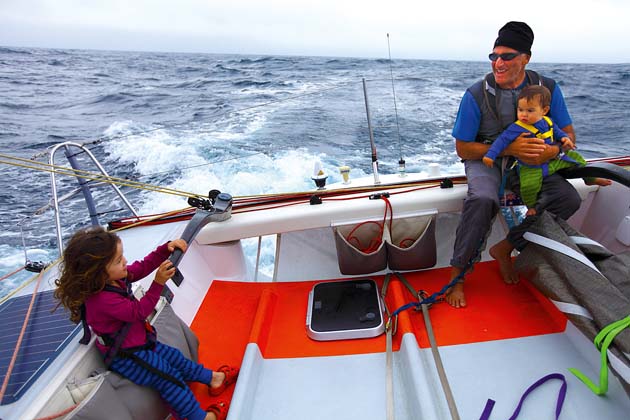Somira Sao describes how her family face losing their home after their Open 40 Anasazi Girl is dismasted close to Cape Horn on an eastbound circumnavigation
I carefully shifted my weight so I could crawl out of the berth without waking anyone. Getting out of a space intended for one person, then stepping out over the ballast plumbing was tricky, but it was the safest place to be on the boat on this Southern Ocean passage.
It was February 2014 and we were starting day five of our passage out of Auckland. With 60 days of provisions on board, our plan was to sail non-stop to Lorient, France. This was the first offshore passage for our one-year-old daughter Pearl after a long stop in New Zealand. With many ocean miles under their belts, our daughter Tormentina (5) and son Raivo (3) were now well-seasoned sailors. If we made it to Lorient, it would complete an eastbound family circumnavigation via the three Great Capes.
We were trying to maintain a maximum boat speed of 10-12 knots while staying on an efficient and comfortable course toward the Drake Passage. The plan was simple: sail fast, sail smart, keep the lows on starboard, the highs on port and, above all else, do not get hurt or break anything!
I sat down next to James to see where we were: just over 1,000 miles out of New Zealand, with a stable north-west breeze and moderate seas. The forecast showed we would get a south-westerly windshift in four to six hours.
We discussed turning on the Eberspächer heater for the first time, but the kids were asleep, warm inside the cocoon of a giant down sleeping bag, and we decided to wait. We had 53gal of diesel aboard and were guarding our fuel.
The days that followed fell into a steady routine. These were not the sunny, warm days of sitting in the cockpit with the kids and watching for dolphins, birds and whales like in the Atlantic. Southern Ocean sailing was more of a risk management programme.
Keeping the kids safe
The kids understood that we were safest down below and when conditions were aggressive, it was best to be in the quarterberths. Effectively, James was sailing single-handed. He made all sail changes on deck, checked the condition of sails, lines and deck gear, and obsessively checked and rechecked all our systems. On deck he always stayed clipped on and wore a lifejacket and harness.
Down below my responsibility was keeping the kids safe. All physical movement was always controlled. Even for our older children to use the head or move about the cabin required supervision. My eyes were constantly on them and on the instruments, watching for imminent or unexpected changes in wind speed or direction. If the kids were all asleep and tucked in safely, then James and I could sometimes make a co-ordinated sail change, with me driving the boat down below with the autopilot and him on deck above.
Twice a day, we ran the Yanmar for 1-2 hours to charge the batteries, always a loud exercise inside the uninsulated carbon hull. During this time, we did all our power-intensive tasks: ran the watermaker, booted up the computer to update our position, downloaded new weather files and charged the kids’ tablets. Once this was done, we allowed the kids to watch one movie on the boat computer.
In the quieter times or when it was rough, we took turns sleeping, reading or telling the kids stories.
On day 17, James overlaid a weather file on the chart that made us both stop and stare. We were about 1,300nm from Cape Horn. The forecast showed a monster low approaching, very fast and very powerful. Our hope was to stay ahead of it, but we were sure to get some strong winds and big seas. We prepared for the big blow, making sure everything on board was strapped down and put away.
As seas grew bigger and winds increased over the next three days, we spent most of that time hunkered down in our berths. The seas were magnificent dark blue walls that rose up behind us like mountains. As they peaked and the sun shone through, they turned crystalline blue, then broke, leaving the dark deep awash in a sea of white foam. Nature had never been more beautiful, dangerous and powerful.
With four reefs in the main and a fully battened storm jib, we covered just over 1,000 nautical miles over three days. Winds were between 40-50 knots, gusting 60-70.
By first light on day 21, the wind at last abated, and we felt our muscles relax for the first time in days. We were 300nm west of the Diego Ramirez Islands and excited to know that we would be around the Horn within the next day or so.
The wind had gone down, but the sea state was still large, periodically bringing a big wave that slammed into the side of the boat. After days of being crammed together in one berth, Tormentina was stretching out, sleeping alone in the port side quarterberth. James was lying on the navstation seat, boots still on.
He had his eyes closed and was fighting a headache that was threatening to turn into a migraine. I was in the starboard berth, watching the instruments, while Raivo and Pearl both slept.








